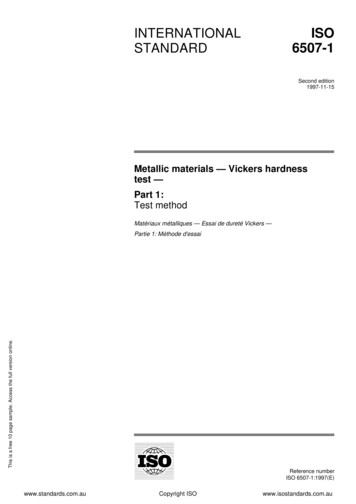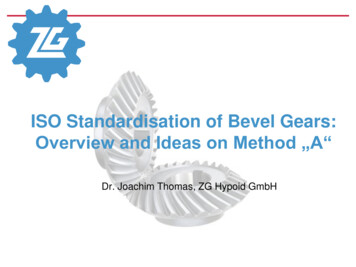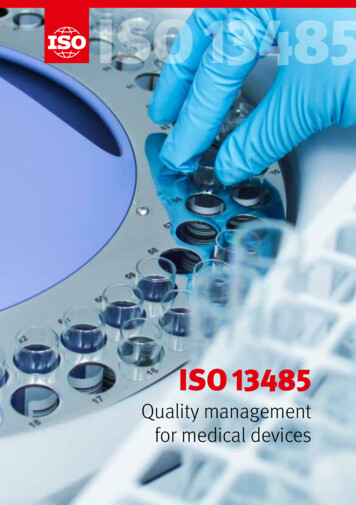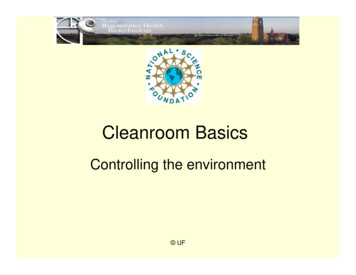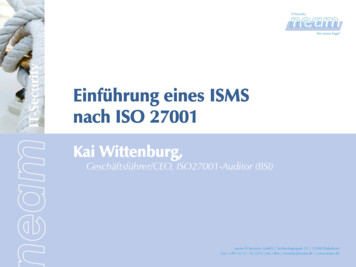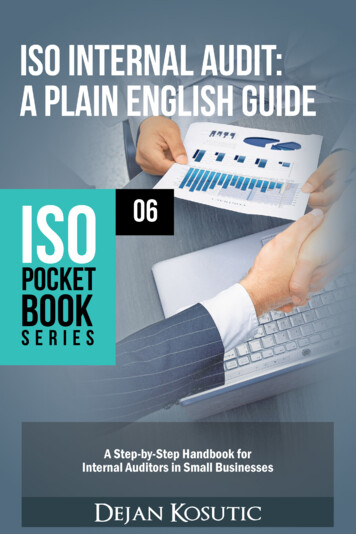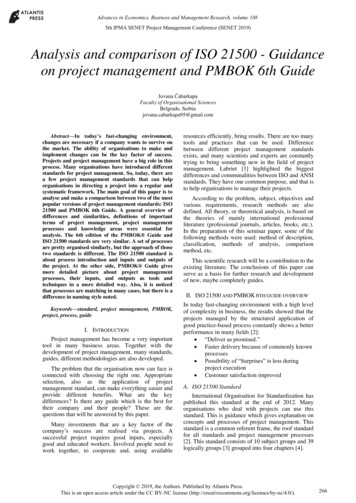
Transcription
Advances in Economics, Business and Management Research, volume 1085th IPMA SENET Project Management Conference (SENET 2019)Analysis and comparison of ISO 21500 - Guidanceon project management and PMBOK 6th GuideJovana ČabarkapaFaculty of Organisational SciencesBelgrade, Serbiajovana.cabarkapa95@gmail.comAbstract—In today’s fast-changing environment,changes are necessary if a company wants to survive onthe market. The ability of organisations to make andimplement changes can be the key factor of success.Projects and project management have a big role in thisprocess. Many organisations have introduced differentstandards for project management. So, today, there area few project management standards that can helporganisations in directing a project into a regular andsystematic framework. The main goal of this paper is toanalyse and make a comparison between two of the mostpopular versions of project management standards: ISO21500 and PMBOK 6th Guide. A general overview ofdifferences and similarities, definitions of importantterms of project management, project managementprocesses and knowledge areas were essential foranalysis. The 6th edition of the PMBOK Guide andISO 21500 standards are very similar. A set of processesare pretty organised similarly, but the approach of thosetwo standards is different. The ISO 21500 standard isabout process introduction and inputs and outputs ofthe project. At the other side, PMBOK Guide givesmore detailed picture about project managementprocesses, their inputs, and outputs as tools andtechniques in a more detailed way. Also, it is noticedthat processes are matching in many cases, but there is adifference in naming style noted.Keywords—standard, project management, PMBOK,project, process, guideI. INTRODUCTIONProject management has become a very importanttool in many business areas. Together with thedevelopment of project management, many standards,guides, different methodologies are also developed.The problem that the organisation now can face isconnected with choosing the right one. Appropriateselection, also as the application of projectmanagement standard, can make everything easier andprovide different benefits. What are the keydifferences? Is there any guide which is the best fortheir company and their people? These are thequestions that will be answered by this paper.Many investments that are a key factor of thecompany’s success are realised via projects. Asuccessful project requires good inputs, especiallygood and educated workers. Involved people need towork together, to cooperate and, using availableresources efficiently, bring results. There are too manytools and practices that can be used. Differencebetween different project management standardsexists, and many scientists and experts are constantlytrying to bring something new in the field of projectmanagement. Labriet [1] highlighted the biggestdifferences and communalities between ISO and ANSIstandards. They have one common purpose, and that isto help organisations to manage their projects.According to the problem, subject, objectives andvarious requirements, research methods are alsodefined. All theory, or theoretical analysis, is based onthe theories of mainly international professionalliterature (professional journals, articles, books, etc.).In the preparation of this seminar paper, some of thefollowing methods were used: method of description,classification, methods of analysis, comparisonmethod, etc.This scientific research will be a contribution to theexisting literature. The conclusions of this paper canserve as a basis for further research and developmentof new, maybe completely guides.II. ISO 21500 AND PMBOK 6TH GUIDE OVERVIEWIn today fast-changing environment with a high levelof complexity in business, the results showed that theprojects managed by the structured application ofgood practice-based process constantly shows a betterperformance in many fields [2]: “Deliver as promised.” Faster delivery because of commonly knownprocesses Possibility of “Surprises” is less duringproject execution Customer satisfaction improvedA. ISO 21500 StandardInternational Organisation for Standardization haspublished this standard at the end of 2012. Manyorganisations who deal with projects can use thisstandard. This is guidance which gives explanation onconcepts and processes of project management. Thisstandard is a common referent frame, the roof standardfor all standards and project management processes[2]. This standard consists of 10 subject groups and 39logically groups [3] grouped into four chapters [4].Copyright 2019, the Authors. Published by Atlantis Press.This is an open access article under the CC BY-NC license 66
Advances in Economics, Business and Management Research, volume 108ISO 21500 gives high-level concepts and processesdescription. Focus of ISO 21500 standard is onconcepts used in project management and theirrelation. One aspect of this standard also covers theprocesses of project management. Recommendationfrom the standard is that the processes should befollowed for the whole project and individual phases.An organisation that uses this standard don’t show justbetter performances in term with lower costs andshorter delivery deadlines, but also a high level ofsatisfaction of client needs. [4] This standard is createdto help organisations to achieve professionalexcellence. The best way to achieve objectives of theproject is to confirm results to certain requirementsincluding, for example, cost, time, and other resources[5]. For organisation who wants to maintain goodcommunication through the project, this ISO 21500standard could be very useful.There are two perspectives processes for viewingthe processes: process groups from the managementperspective or as subject groups from the perspectiveof a specific theme [4]. It is not prescribed how theprocesses or structures should be applied or executed.There is an existence of many shortcomings within thestandards [5].Shepherd Miles, who developed the new standard,said - “ISO 21500 enables people in any organisationto understand how the discipline fits into a businessenvironment. It is also intended to be used as a basicguide, aimed at the informed reader without an indepth knowledge of project management.”B. PMBOK Guide 6th editionPMI was founded in 1969 by the AmericanNational Standards Institute (ANSI) using a processbased approach. In 1987 the first version of PMBOKGuide (Project Management Body of Knowledge) waspublished, in an attempt to standardise informationand practices in project management general. [6]This Guide introduces one part of the projectmanagement that is recognized as good practice whichmeans that application of knowledge, skills,techniques and tools can be a very big influencer overprojects. The project team and stakeholders are tryingto find the best combination of processes, tools,techniques, inputs and outputs that can help to managethe project.There are five basic process groups, ten typicallyknowledge areas and 49 processes that are recognisedby PMBOK 6th Guide. Through a project, manyprocesses overlap and interact, and every process hasdefined using: Inputs (plans, documentations, designs, etc.)Tools and TechniquesOutputs (product, documents, etc.)III. METHODOLOGYISO 21500 Standard and PMBOK have conceptsand content that is similar. These standards will beanalysed in a way which will give a clear picture ofsimilarities and differences. Three sections that areselected for analysis are: General comparisonProject Management processesProject Management KnowledgeIV. RESEARCH FINDINGSA. General comparisonIf we looked at the history, we would see that ISOstandard came second, after all, approvals bycommittees. It was released on August 2012. ANSIStandard with the PMBOK Guide 4th edition camefirst. Because of that, in ISO standard it could be seenthat many processes are used. One big change wasonly connected with stakeholder management, whichwas introduced by ISO. In the second edition ofPMBOK Guide, that section was also included. It isrecognised by many international organisations whichare represented in the project management profession.PMBOK Guide from 2013 has confirmed this fact,and it shares the same structure with different namefor some processes, but the similarity has a bigpercentage. [4]The ISO 21500 standard has 47 pages. It has afocus on the introduction of the processes and inputsand outputs used. On the other side, PMBOK Guidedescribes, through 978 pages also projectmanagement processes, inputs, outputs, and tools andtechniques that can be used.TABLE 1 – STAGE, TOPICS AND PROCESSES COMPARISONStagesTopicsISO 215005Ten subject groupsProcesses39 processesPMBOK Guide 6th5Ten knowledgeareas49 processesISO 21500 eliminates the processes tools andtechniques because it leaves space for experts tochoose and combine them to get the best combinationfor the project. In some fields, recommendation andsuggestions of tools and techniques can confuse andcreate a barrier for problem-solving, but sometimescan be very helpful. Unlike PMBOK Guide 6th, ISO21500 doesn’t describe inputs and outputs of theprocesses, and there are not any stages of a project.B. Definition of “Project” and “ProjectManagement”Existing literature shows many different definitions ofproject and project management. In projectmanagement standards that are the subject of thispaper also can be found their definition of thoseterms.Definition of the project can be found in section 3.2 inGuide.ISO 21500 - The definition of the project is: “Aproject is a unique set of processes consisting of267
Advances in Economics, Business and Management Research, volume 108coordinated and controlled activities with start andfinish dates, undertaken to achieve an objective.Achievement of the project objective requiresdeliverables conforming to specific requirements,including multiple constraints such as time, cost andresources.” [2]To get the best results from the project, projectteam, including project manager, must pay attention toconcepts (topics) named “Knowledge areas” inPMBOK Guide, and “Subject groups” in ISO 21500Standard.TABLE 2 – PROCESS COMPARISONthPMBOK Guide 6 - The definition says that theproject is “a temporary endeavour undertaken tocreate a unique product, service, or result” [6]There is a difference between those twodefinitions. Definition of ISO 21500 doesn’t have aword “product” in definition, so that can be maybeunclear. Also, the definition of PMBOK ntation.Project management – ISO 21500 definition:“Project management is the application of methods,tools, techniques and competencies to a project.Project management includes the integration of thevarious phases of the project life cycle. Projectmanagement is accomplished through processes” [2].Project management – PMBOK Guide 6thdefinition: “Project management is the application ofknowledge, skills, tools, and techniques to projectactivities to meet the project requirements. Projectmanagement is accomplished through the appropriateapplication and integration of the project managementprocesses identified for the project. Projectmanagement enables organisations to execute projectseffectively and efficiently. [6]Those two definitions are pretty similar becausethey both include tools and techniques that need to beused to meet the requirement of the project.Also, both definition mention processes as avery important part of project management. Manyprocesses can be similar (same stakeholders,resources used, deliverables provided by the project,etc.) but each project is somehow unique.There is a project of all types and level ofcomplexity, and the organisation’s responsibility is toset the objective for the project.C. Project Management ProcessesProcesses are the most important area in ProjectManagement science. Because of that, this part isdevoted to them. PMBOK and ISO 21500 have somevisions about the processes, and in this part of theanalysis, the focus is on finding similarities anddifferences in their imagination of processes. One ofthe differences between these guides is that processesfrom ISO 21500 standard have a different approach tothe scope definition.Now, especially PMBOK Guide 6th edition ismore attractive than ISO 21500 because of the agileapproach to processes.ISO LIMControllingCOClosingCLPMBOKGuide lingClosingAbbreviationIPEMCD. Project Management Knowledge areaStaff arranged to work on the project must follow theproject plan constantly. In ISO 21500, ProjectManagement Knowledge is called Subject groups,and in PMBOK Guide 6th, it is called Knowledgeareas. But the meaning remains the same. There areten items on this list [6]: ommunicationRiskProcurementStakeholdersEach of listed has its sub-processes. Subprocesses and the differences between ISO 21500 andPMBOK Guide 6th are shown in tables from 3 to 12.TABLE 3 – COMPARISON – INTEGRATIONIntegrationSubjectSub-processISO 215004.3.2 Develop Project Charter4.3.3 Develop Project Plans4.3.4 Direct Project Work4.3.5 Control Project Work4.3.6 Control Changes4.3.7 Close Project Phase or Project4.3.8 Collect Lessons LearnedKnowledgeSub-processPMBOK Guide6thI - 4.1 Develop Project CharterP - 4.2 Develop Project Management PlanE - 4.3 Direct and Manage Project WorkE - 4.4 Manage Project KnowledgeM - 4.5 Monitor and Control Project WorkM - 4.6 Perform Integrated Change ControlC - 4.7 Close Project or PhaseIn this table, sub-processes are shown. They arevery similar instead of one step. That is CollectLessons Learned that exists in ISO 21500 Standard,268
Advances in Economics, Business and Management Research, volume 108which is essential for evaluation of the projectconducted and also for collecting shareableexperience.TABLE 4 – COMPARISON – SCOPEScopeSubjectSub-processISO 215004.3.11 Define Scope4.3.12 Create WBS4.3.13 Define Activities4.3.14 Control ScopeKnowledgeSub-processPMBOK Guide6thP - 5.1 Plan Scope ManagementP - 5.2 Collect RequirementsP - 5.3 Define ScopeP - 5.4 Create WBSM - 5.5 Validate ScopeM - 5.6 Control ScopeTABLE 7 – COMPARISON – QUALITYQualitySubjectSub-processISO 215004.3.32 Plan Quality4.3.33 Perform Quality Assurance4.3.34 Perform Quality ControlKnowledgeSub-processPMBOK Guide6thP - 8.1 Plan Quality ManagementE- 8.2 Manage QualityM - 8.3 Control QualityQuality knowledge area/subject is at first verysimilar. But if a deeper look is taken, it can be seenthat ISO 21500 is using the term “Quality Assurance”which is one part of Quality Management.TABLE 8 – COMPARISON - RESOURCESIn both Guides, scope exists, but one conclusiongiven by Tavan and Hosseini was that PMBOK has adetailed scope than ISO 21500. They said thatPMBOK gives an introduction of organisationalimpacts such as environmental impacts, style, cultureand organisational structure. [7]ResourceTABLE 5 – COMPARISON – TIME/SCHEDULESubjectSub-processISO 215004.3.15 establish project team4.3.16 estimate resources4.3.17 define project organisation4.3.18 develop project team4.3.19 control resources4.3.20 manage project teamKnowledgeSub-processPMBOK Guide6thP - 9.1 Plan Resource ManagementP - 9.2 Estimate Activity ResourcesE - 9.3 Acquired ResourcesE - 9.4 Develop TeamE - 9.5 Manage TeamM - 9.6 Control ResourcesTime/scheduleSubjectSub-processISO 215004.3.21 Sequence Activities4.3.22 Estimate Activity Durations4.3.23 Develop Schedule4.3.24 Control ScheduleKnowledgeSub-processPMBOK Guide6thP - 6.1 Plan Schedule ManagementP - 6.2 Define ActivitiesP - 6.3 Sequence ActivitiesP - 6.4 Estimate Activity DurationsP - 6.5 Develop ScheduleM - 6.6 Control ScheduleThese sub-processes listed in the table have thesame flow, but it is noted that PMBOK Guide 6th ismore detailed because it has some sub-processes thatare included before, and are very important (forexample – Plan Schedule Management).TABLE 6 – COMPARISON – COSTCostSubjectSub-processISO 215004.3.25 Estimate Costs4.3.26 Develop Budget4.3.27 Control CostsKnowledgeSub-processPMBOK Guide6thP - 7.1 Plan Cost ManagementP - 7.2 Estimate CostsP - 7.3 Determine BudgetM - 7.4 Control CostsLike in the previous table, one very essential subprocess is included in PMBOK Guide 6th, and not inan ISO 21500. Planning is a very good start for a leanand very organised and fast flow.For this topic (Resources), it is noticed that theseparate process for planning of resources does notexist. After the team is established, the process ofdefining a project organisation is provided later.TABLE 9 – COMPARISON – COMMUNICATIONCommunicationSubjectSub-processISO 215004.3.38 Plan Communications4.3.39 Distribute Information4.3.40 Manage CommunicationKnowledgeSub-processPMBOK Guide6thP - 10.1 Plan Communications ManagementE - 10.2 Manage CommunicationsM - 10.3 Monitor CommunicationsIt is noticed that processes are matching, butthere is a difference in naming style noted. The subprocess “Distribute information” has the samepurpose as “Manage Communication” in PMBOKGuide 6th. The other difference is in the last step.The goal of the sup-process “ManageCommunications” in ISO 21500 is control andimprovement communication, and that is also thefunction of the last sub-process in PMBOK Guide 6th.269
Advances in Economics, Business and Management Research, volume 108TABLE 10 – COMPARISON – RISKRiskSubjectSub-processISO 215004.3.28 Identify Risks4.3.29 Assess Risks4.3.30 Treat Risks4.3.31 Control RisksKnowledgeSub-processPMBOK Guide6thP - 11.1 Plan Risk ManagementP - 11.2 Identify RisksP - 11.3 Perform Qualitative Risk AnalysisP - 11.4 Perform Quantitative Risk AnalysisP - 11.5 Plan Risk ResponsesE - 11.6 Implement Risk ResponseM - 11.7 Monitor RisksAt first look, it would be said that the difference ispretty obvious. First difference noted is alsoconnected with the planning process. The ISO 21500standard does not include that sub-process. Assessrisk is one sub-process in ISO 21500 that has samefunction like sub-processes 11.3 and like subprocesses 11.3 and 11.4 in PMBOK Guide 6th. Nextsub-process “Treat risk” is maybe very similar or thesame as the sub-process 11.5 Plan Risk Responsesand maybe somehow includes 11.6 in its scope.TABLE 11 – COMPARISON – PROCUREMENTProcurementSubjectSub-processISO 215004.3.35 Plan Procurements4.3.36 Select Suppliers4.3.37 Administer ContractsKnowledgeSub-processPMBOK Guide6thP - 12.1 Plan Procurement ManagementE - 12.2 Conduct ProcurementsM - 12.3 Control ProcurementsSub-processes for procurement remain very similar.Although otherwise named, sub-processes 4.3.36from ISO 21500 and 12.2. Conduct Procurementshave the same function.TABLE 12 – COMPARISON – STAKEHOLDERSStakeholdersSubjectSub-processISO 215004.3.9 Identify Stakeholders4.3.10 Manage StakeholdersKnowledgeSub-processPMBOK Guide6thI - 13.1 Identify StakeholdersP - 13.2 Plan Stakeholder EngagementE - 13.3 Manage Stakeholder EngagementM - 13.4 Monitor Stakeholder EngagementIt is clear that PMBOK Guide 6th is wider, i.e. itincludes two more sub-processes than ISO 21500:13.2. Plan Stakeholder Engagement and 13.4. MonitorStakeholder Engagement.V. CONCLUSIONThe analysis and comparison between ISO 21500and PMBOK Guide 6th have been performed. In thispaper, processes and sub-process of projectmanagement together with subject groups (knowledgeareas) are analysed and compared, also as differencesbetween defining some terms. The analysis showedthe strengths and weaknesses of both Guides.Every organisation is unique, somehow. Becauseof that, every organisation has different needs andrequirements. Taking that into consideration will helpmanagers to choose a suitable standard for theirproject. PMBOK standard has focused on projectmanagement, unlike ISO 21500 Standard which isfocused on an individual project.Maybe theappropriate combination will bring the best results. Inhis paper, Grau [11] writes about national andinternational standards and about one model called„Project Excellence Modell der IPMA“. Also, in thatpaper Grau wrote some suggestions for usage ofstandards in a reasonable mix.Many pieces of research, experiences and studiesshowed that strategic level of Project Management hasincreased [7]. Maybe one day ISO 21500 standard willbe standard for certification. In that case, manycompanies could get an advantage if they havecertified projects and project managers.Because of the consistency between thosestandards, the author thinks that that will have aninfluence on improvement and that will help theprofession. Change is a must today, so organisationswho develop the standards, also as an organisationwho use it, need to follow innovative ways of doingsomething and to try to integrate that into the “goodpractice guide”. PMBOK Guide 6th connection withagile was one big step because people connect thatwith words “easily”, “quickly” as it is supposed to be.Nonetheless, results from this study must beinterpreted with caution because there may be somepossible limitations. The time available to study thestructure and content of those two standards in a moredetailed way was constrained by the deadline. Also,this study doesn't provide a view of experiences fromthe companies who are using them in their processes,but this paper could be the base for some futureresearch in that direction. Results of detailed analysisof the advantages and disadvantages of existingstandards in this area can create the potential for thedevelopment of a new model that could takeadvantage of both and eliminate the disadvantages ofeach standard.REFERENCES[1][2][3][4][5]T. Labriet. Comparing PMBOK Guide 4th Edition,PMBOK Guide 5th ed., and ISO 21500. Lausanne, 2012.International Organisation for Standardization. ISO 21500 Guidance on project management. Switzerland: ISO, 2012.M. Otero-Mateo, A. Pastor-Fernandez and J. Portela-Nuñez.“Influence of standard ISO 21500 in the management ofcollaborative networks.” In Material Science forum 797,2014, pp.9-14.A. Zandhuis and R. Stellingwerf. ISO 21500 Guidance onproject management. Netherland: Van Haren Publishing,2013.F. Cobbinah “Project Management Standards andImprovements.” Northcentral University, 2018.270
Advances in Economics, Business and Management Research, volume 108[6][7][8][9]Project Management Institute. A Guide to the ProjectManagement Body of Knowledge (PMBOK Guide).Pennsylvania, 2017.F. Tavana and M. Hosseinib “Comparison and analysis ofPMBOK 2013 and ISO 21500.” Journal of ProjectManagement ,2016, pp. 27-34.IPMA. Individual competence baseline for project,programme & portfolio management. 4th ed. Zurich: IPMA,2015Z. Mitrović., D. Bjelica, M. Pavićević. “The UnderlyingTheory Of Project Management - A Systematic Review AndResearch Agenda.” XVI International Symposium Symorg.Zlatibor: University of Belgrade, Faculty of OrganisationalSciences, 2018. 167-172.[10] C. Williams. Principi menadžment. Belgrade: Data Status,2011.[11] N. Grau. „Standards and Excellence in Project Management –In Who Do We Trust?” Procedia - Social and BehavioralSciences 74 ( 2013 ) 10 – 20; 26th IPMA World Congress,Crete, Greece, 2012,271
Now, especially PMBOK Guide 6th edition is more attractive than ISO 21500 because of the agile approach to processes. To get the best results from the project, project team, including project manager, must pay attention to concepts (topics) named "Knowledge areas" in PMBOK Guide, and "Subject groups" in ISO 21500 Standard. T. ABLE




